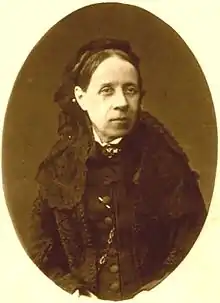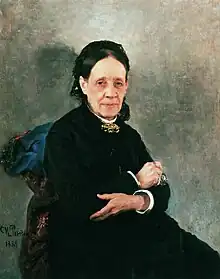Nadezhda Stasova
Nadezhda Vasilievna Stasova (Russian: Наде́жда Васи́льевна Ста́сова; 1822 – September 27, 1895[1]) was a Russian educator, activist and feminist. She worked to give Russian women greater access to education. A notable philanthropist, she was also, alongside Anna Filosofova (1837–1912) and Maria Trubnikova (1835–1897), one of the pioneer founders and leaders of the first organised Russian women's movement. Together, the three were referred to as the "triumvirate".[2][3]

Early life
Stasova was born at Tsarskoye Selo in 1822.[2] Her parents were members of the Russian nobility. Her father, Vasily Stasov, was a prominent architect.[2] Tsar Alexander I of Russia was her godfather.[4] Stasova was one of seven children; she had five brothers (including Vladimir and Dmitry) and a sister, Sonya.[4] Her mother died in 1831 of cholera, when Stasova was nine years old.[4] In later years, she regarded the childhood education she received as frivolous and recalled that her father and brothers did not feel women required serious education.[4]
As a young woman, Stasova was engaged to a military officer. However, shortly before their wedding, her fiancée left her and married another woman under severe parental pressure.[4] Stasova, desolate, subsequently vowed that she would never marry.[4] She began educating herself by reading extensively.[4] Her sister, Sofya, with whom she was very close, died of consumption in 1858.[4] Stasova decided to direct her energies away from her own family and towards the "universal family" of the needy and dispossessed.[2][4] Stasova, discussing the limited options available to women at the time, later wrote that Russian feminists desired "not the moonlight, but rather the sunlight."[5]
Career
Through Maria Trubnikova's salon, Stasova became connected with a large group of wealthy women concerned with the economic and educational status of women in Russia.[4] Stasova (along with Trubnikova, Filosofova, and others) founded the Society for Cheap Lodgings and Other Benefits for the Citizens of St. Petersburg in 1859.[2][4] The group had two factions, the "German party" and the "Russian party", which differed on their preferred approach.[3] The "Germans" favored a then-traditional method of philanthropy focused on giving to institutions, with close supervision of the poor. The "Russians" focused on self-help and direct aid, attempting to avoid patronization and maintain the privacy of those aided.[3][4] In early 1861, the organization split in two, with the Stasova-Trubnikova-Filosofova triumvirate leading the "Russians".[3] The reduced group's charter was approved in February 1861.[3][4] The organization provided housing and work as seamstresses to its female clients (primarily widows and wives whose husbands had abandoned them).[3] It included a day care and a communal kitchen.[3]
In 1860, meanwhile, Stasova founded a school aimed at teaching literacy to blue collar women, as part of the brief Sunday school movement in Russia.[2][6] The school was closed by the Russian government in 1862.[6] In response, Stasova began teaching classes at her home instead.[7] Stasova was also involved with a shelter at the Kalinkin Hospital treating prostitutes affected by sexually transmitted infections.[7] In 1863, Stasova, Trubnikova and Anna Engelhardt founded the first Russian Women's Publishing Cooperative.[7][8] Employing upwards of thirty women, the cooperative focused on writing and translation. It published a wide variety of books, including textbooks, scientific works and children's stories.[9]

Trubnikova and Stasova also began pushing, in 1867, for Russian universities to create courses for women.[2] Demonstrating "considerable skill in rallying popular support", according to the historian Christine Johansen, the women wrote a carefully-worded petition to Tsar Alexander II. They gathered over 400 signatures among middle and upper-class women.[11] However, there was widespread opposition to the education of women, including by the relevant minister, Dmitry Tolstoy.[7] Tolstoy argued that women would abandon education after being married, and dismissed the signatories by stating that they were "sheep" merely following the latest fashion. He rejected the petition in late 1868, but allowed mixed-gender public lectures which women could attend.[11] However, these were rapidly taken up, overwhelmingly by women. The "triumvirate" also appealed to war minister Dmitry Milyutin, who agreed to host the courses after being persuaded by his wife, daughter, and Filosofova. Tolstoy countered by allowing the lectures at his own apartments, where he could monitor them.[11] The political movement in favor of women's education continued to grow, and by October 1869, the Russian government permitted a limited set of courses for women on advanced subjects.[2][7][11] Stasova organized these and recruited the professors to teach them; the courses began in January 1870.[7] They were known as the Vladimirskii courses, after their host beginning in 1872, the Vladimir college.[7]
Stasova spent 1871 to 1876 in Germany, caring for two of her nieces, who were ill.[7] One of her nieces, Elena Stasova, became a well-known radical feminist and Bolshevik official.[12] During Stasova's absence, in 1875, the Vladimirskii courses were shut down.[7] She was the first director of the Bestuzhev Courses, beginning in 1878; this was a "permanent educational institution for women."[7] The radicalism of some of the students led to criticism, and Stasova was forced to step down as director in 1889, accused of "inefficiency and muddleheadedness."[2][7]
Later career
Despite this setback, Stasova kept working.[2][7] She helped create the Children's Aid Society in St. Petersburg, and chair of the Society for Assistance for Higher Women's Courses.[2][7] She served as a mentor to Liubov Gurevich and other younger feminists; one scholar writes that Stasova "achieved almost saintlike status among those who knew her, as they noted with awe her unquenchable fervor."[1][4] In 1893, Stasova and others sent an exhibit focusing on the progress of women to the World's Columbian Exposition in Chicago.[1] In 1895, she, Trubnikova, and Filosofova founded the Russian Women's Mutual Philanthropic Society (RWMPS). Stasova led the organization as chair until her death the same year, and was replaced by Anna Shabanova.[2]
Despite illness, she continued working hard until her death on September 27, 1895.[1] Close to the end of her life, she wrote that Russian women "still have not learned to stop being men's slaves. In everything they restrain themselves, are frightened, subordinate... This is bad, very bad! There is much work ahead for women before they will achieve their liberation."[1]
General references
- Arsenyev, Konstantin Konstantinovich, ed. (1907). "Стасова, Надежда Васильевна" [Stasova, Nadezhda Vasilievna]. Энциклопедический словарь Брокгауза и Ефрона [Brockhaus and Efron Encyclopedic Dictionary]. St. Petersburg.
{{cite book}}: CS1 maint: location missing publisher (link)
Citations
- Ruthchild, Rochelle G. (2010). Equality and Revolution. University of Pittsburgh Press. pp. 11–25. ISBN 9780822973751.
- Rappaport, Helen (2001). Encyclopedia of women social reformers. Vol. 2. Santa Barbara, Calif.: ABC-CLIO. pp. 671–2. ISBN 978-1-57607-101-4.
- Engel, Barbara Alpern (2000). "Searching for a politics of personal life". Mothers and daughters: women of the intelligentsia in nineteenth-century Russia. Studies in Russian literature and theory. Evanston, Ill: Northwestern University Press. ISBN 978-0-8101-1740-2.
- Ruthchild, Rochelle G. (2009). "Reframing public and private space in mid-nineteenth century Russia : the triumvirate of Anna Filosofova, Nadezhda Stasova, and Mariia Trubnikova". In Worobec, Christine D. (ed.). The human tradition in imperial Russia. The human tradition around the world. Lanham, Md.: Rowman & Littlefield. ISBN 978-0-7425-3737-8.
- Staties, Richard (2021). The Women's Liberation Movement in Russia: Feminism, Nihilsm, and Bolshevism, 1860-1930. Princeton University Press. p. 34. ISBN 9781400843275.
- Zelnik, Reginald E. (1965). "The Sunday-School Movement in Russia, 1859-1862". The Journal of Modern History. 37 (2): 151–170. doi:10.1086/239634. ISSN 0022-2801. JSTOR 1878307. S2CID 143782960. Archived from the original on 2023-09-28. Retrieved 2023-09-28.
- Muravyeva, Marianna (2006). de Haan, Francisca; Daskalova, Krassimira; Loutfi, Anna (eds.). A Biographical Dictionary of Women's Movements and Feminisms: Central, Eastern, and South Eastern Europe, 19th and 20th Centuries. Central European University Press. pp. 526–9. ISBN 9786155053726.
- "Анна Николаевна Энгельгардт" [Anna Nikolayevna Engelhardt]. Women Museum Encyclopedia (in Russian). Saint Petersburg, Russia: Федерации женщин с университетским образованием (Federation of Women with a University Education). 2012. Archived from the original on 21 April 2017. Retrieved 21 April 2017.
- Kaufman, Andrew D. (2022). The Gambler Wife: A True Story of Love, Risk, and the Woman Who Saved Dostoyevsky. Penguin Books. p. 209. ISBN 9780525537151.
- Mardilovich, Galina; Taroutina, Maria, eds. (2009). New Narratives of Russian and East European Art: Between Traditions and Revolutions. Routledge. ISBN 9780429639784.
- Johanson, Christine (1987). "Chapter II: The Politics of Minimal Concessions - Women's Courses in Moscow and St. Petersburg". Women's struggle for higher education in Russia: 1855 - 1900. Kingston, Canada: McGill University Press. ISBN 978-0-7735-0565-0.
- Uglow, J.; Hendry, M., eds. (2005). "Stasova, Nadezhda". The Palgrave Macmillan Dictionary of Women's Biography. Springer. ISBN 9780230505773.